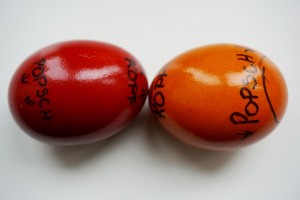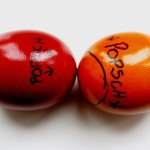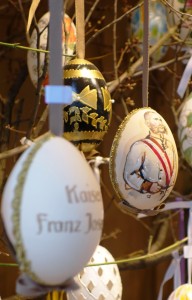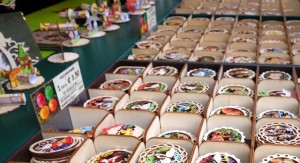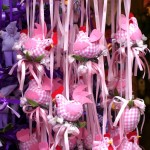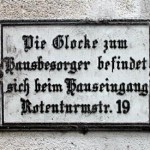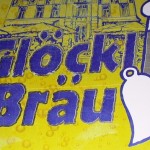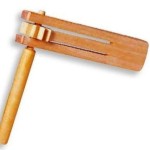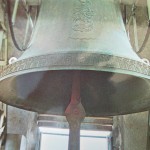EGG BOXING 101 – The Ultimate Guide to Becoming a Winning Egg Boxer
To re-iterate yesterday’s post: America needs to adopt the Austrian Easter tradition of “Eierpecken” – which, as Americans, we will translate in a testosterone-laced manner as “Egg Boxing.” Because what’s a good family get-together without a little raw competition with the least favorite cousins?
Objective: smash or even just crack your opponent’s Easter egg with yours while leaving your egg smooth, crack-free and unscathed.
Needed: two hard-boiled, dyed, Easter eggs, two willing contenders, distinction of the “head” (Kopf) vs. the “butt” (Popsch) of the egg (see photo on right). That’s it. Of course spectators to gush over your victory and Chuck’s defeat never hurt – especially if they are poised and ready to capture the moment for digital eternity.
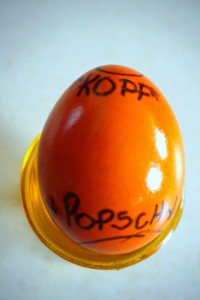
The egg head is the “Kopf” and the most narrow part of the ovid. Egg butt is the “Popsch” or “Po” and is the “bottom” part of the egg.
Step 1: Preparation. As every expert egg boxer can tell you, successful egg boxing begins with the selection of the perfect hen. Yes, in this case, the chicken comes before the egg because young hens produce the most durable eggs. The shells of young hens contain more protein which makes the egg shells harder, thicker, and more durable. So having a young chick in your corner is the first step to victory. (And please don’t use that quote out of context).
Step 2: Boxing stance and footwork. Truth is, there is no proper boxing stance and footwork but it sounds good and can intimidate your opponent so pretend there is: lean your body forward about 5 degrees, tuck your elbows to your hips, keep your chin down (to deflect the impact of the opponent egg) and – very important – don’t ever cross your feet! (to ensure maintained balance). Relax and breathe!
Step 3: Head or Butt? Before the competition can begin, opponents must reach a decision if they will attack each other with the head (Kopf auf Kopf) or the Butt (Popsch auf Popsch) of the egg. If no decision can be amicably reached, this can be determined by the trusty old coin toss.
Step 4: Technique. Now we get into math and physics. If you are going head-to-head then you want to attack with the most durable part of your egg – which is the very tip. Eggs are ovid-shaped (and you always thought they were egg-shaped!) and the strongest part of an ovid is its narrow tip so that’s your lethal weapon.
Step 5: Focus and Aim. So if the hardest part of the ovid is the tip, you are going to target your right straight jab to strike your opponent’s egg a bit to the side rather than directly at the tip.
Step 6: Defensive Technique. Don’t leave yourself open. If he or she comes at you directly head-to-head then defend your egg with your thumb and pointer finger. Leave only the very tip of your egg free for attack.
Step 7: Go for the Gold! Throw your jab with a forward step. Great egg boxers have great jabs. The less effort the faster and more powerful you will be.
Step 8: Butt to Butt! No one ever accused you of being a bad sport. Once you’ve smeared Charlie head-to-head be an upstanding guy. Offer him a re-match: Butt to butt! And then win that one too.
Step 9: Revel in victory, you champion you. Shake hands, offer your opponent the salt shaker, shine your unbroken egg and tell Charlie it’s not about winning or losing, but how he played the game. Then upload your egg-boxing photos and texts your fans the winning news. Under no circumstances should you accept any egg boxing challenges from Nana. She might act like a sweet old lady and rookie as she sets aside her needle work and innocently lifts her pink-swirled Easter egg but don’t let her fool you. Ladies over 70 are well-known to be ruthless egg boxers with decades of golden egg trophies tucked away in their yarn baskets.
Egg Boxing Over-achievers, Science Geeks and Engineers: There are more methods that can be applied to winning egg boxing but these sadly exceed my understanding. Spannungstrajektorien, for example, which is apparently stress – strain trajectory can be useful but if you can understand the supposed English explaining it, then you shouldn’t be wasting your time egg boxing but maybe inventing the next alternative to fossil-fuel reliant modes of transportation. I suspect it’s a lot of complicated words that simply re-iterate that with the appropriate velocity and angle of your blow aimed at the most vulnerable part of the opponent’s egg, you will be a winner every time. As long as your opponent hasn’t played dirty and armed himself (or herself if you got suckered into battling Nana) with a plaster-filled Easter egg.
Did you find these tips helpful? If so, please share with other aspiring egg boxers and help bring a bit of raw brutality to the Easter festivities and make Egg Boxing the new American Easter tradition.
Also check out previous Easter posts:
Easter in Austria vs. Easter in the US
Vienna’s Easter Markets
When the Bells Fall Silent and Fly to Rome: Holy Thursday to Easter Night
Who can resist the Egg Bear – Austrian word of the week
“Egg knockin” at the retirement home – check it out: https://www.youtube.com/watch?v=1j2yJtea6Ug

